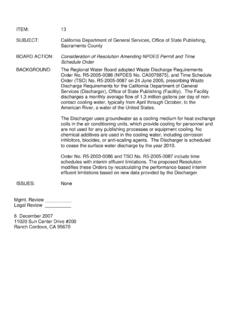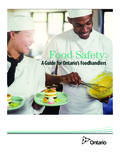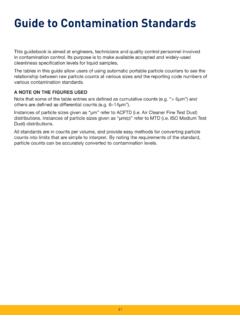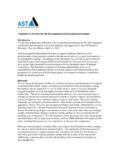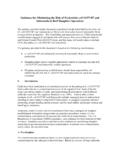Transcription of REMEDIATION GUIDANCE PETROLEUM AND VOC …
1 ~. -.. -~ ' ~ . ' REMEDIATION GUIDANCE FOR .. PETROLEUM AND VOC IMPACTED .. -a-: ~--: SITES .. SECTION II .. ' .. ,. ,.. ' ..' . ; : t . -~ .. ]" \; - _, ,_ . ;, r : . ~ -~ .. -,; . --.: .~.. --- , . : _~ ~-. -~ . ' r .. ' .. ;.. ,_,.. ; , .._ .. :: .. - . : -~ :-' .. --~ -., .. "1: ~ r. """~ _,.. ~-: r .. ; .:- .. " -~ .. , .~; : .. ~: .-; .. -.. ;.:.--: ; ,: - ~ '-;; 0 ~ : .. -..,. :):' .. :' .. ' . _\ ._ .. ' .. ~ .: .. ~- .. ' . : ~~-. : !- . ~.~ .;: . -:' .. ,I . - , ' -~. , . ('' .. -~ .. : .. :_---.. ~-o; ~ .. ' .. :_ :. -~. -.. "l' .. ~:.. : -~-:~:-.. ~:-. ~ .. ' . , , .. -.'.
2 E . GUIDANCE for PETROLEUM -Impacted Sites: Soil Screening Levels-May 1996 Summary . This chapter explains an interim approach, or ~ " GUIDANCE , using numerical soil screening levels, to evaluate the need for REMEDIATION of soils contaminated by PETROLEUM hydrocarbons. Use this approach to find out when a site requires remedial action or what level of REMEDIATION you must reach to conclude the envirorunentaJ study and cleanup, thus reaching "site closure. This approach defines the differences in requirements between types of certain chemicals, or "constituents, in PETROLEUM hydrocarbons and between drinking and non-drinking water ,aquifers -:-underground water-saturated formations from which water flows into wells and springs.
3 You can still use "risk analysis" (determining the long-tenn effect of . residual contaminants on 1 groundwater and their potential hazard for t people) for particular sites and/or "fate and transport models" (the mathematical models that show what happens to chemicals as they move . through soil or -water) that consider groundwater protection, to propose alternate soil cleanup levels. This GUIDANCE also includes "Closure Criteria for Low Risk Fuel contamination Sites . The approach in this GUIDANCE does not replace any site assessment requirements of the Regional Board. This interim GUIDANCE , or amendments to it, will be in effect until the State Water Resources Control Board finishes a new field guide -the "Leaking Underground Fuel Tanks" (LUFT) manuai CRWQCB-LA MAY 1996 GUIDEBOOK - for cleaning up contamination from leaking underground tanks, Then the Board will review the "interim GUIDANCE for further use.
4 Background The Regional Board created the Water Quality Advisory Task Force to identify and recommend ways to reduce the cost of meeting existing clean water Jaws without compromising water quality and public health. The Task Force focused its deliberations on certain problem areas, one of which was site cleanup. In reviewing this area, the Task Force found that "there is no clear definition of what is clean," and that cleanup expectations were not consistent across all Regional Board programs. The Task Force also recommended forming a Technical Review Committee (TRC), composed of representatives from the private and public sectors, to discuss existing and proposed programs, . and to devise cleanup standards in concert with Regional Board staff.
5 The Task Force stated: "Establishing a set of clear and consistent standards for site cleamtp should be the first task un_dertaken by the Regional Board staff and its Technical Review Committee. The Regional Board should establish standards for identifying when a threat or probable threat to groundwater has occurred and when a site has been adequately remedied .. the Regional Board should make eVery effort to ensure that the standards are consistent GUIDANCE for'Jletroleum-Impacted Sites across all programs under its jurisdiction, and, whenever possible, conSistent with those of other agencies in the Region_ The standards should allow the community to use more cost-effective methods, such as risk-assessment approaches, and fate and transport models where appropriate, as means to determine if soil contamination poses a risk to groundwater".
6 Objective The following guidelines aim to simplifY the REMEDIATION process by making it easy to _ choose levels of screening for contaminants at - _ a certain site ("site-specific soil screening levels"). This works for most petrol~um-impacted sites in a way that both protects water resources and is stiJI cost effectiv~. Through this approach, the Board .seeks to encourage prompt cleanups that restore sites to their intended uses. :;--'"The approach relates onJy to the evaluation of , ' PETROLEUM -impacted soils and does not address groundwater directly. Before using the approach, however, you must complete a thorough site characterization and assessment. This should be a highly detailed review and.
7 Sampling, providing information about the types of contaminants and how far they spread into the soil.. The Regional Board intends to .. close investigations of PETROLEUM -impacted sites based on this " GUIDANCE ." The closure is subject to land-use or gaining new information about the site. However, the Board may require groundwater monitoring if it confirms that soil contamination has CRWQCB-LA MAY 1~ GUIDEBOOK impacted groundwater. The attached Table 4-1 provides the basis for the " GUIDANCE " procedures. Table 4-1 defines the soil screening levels above drinking water aquifers; below it are footnotes which explain the concentration screening levels of chemical Components and clarifY the procedures, as well is the screening levels to be used for sites above non-drinking water aquifers.
8 Since there is no adequate measure of risk or toxicity for total PETROLEUM hydrocarbons (TPHs) per se, the screening levels for TPHs in Table 4-1 are based on the carbon range numbers of the TPHs_ These ranges reflect the mobility of the material; the shorter carbon-chain TPHs (C4-C12) move more easily in soil than . the longer carbon-chain TPHs (C23-C32). The table is organized into a .matrix of screening "levels", based on distance of constituents above groundwater and carbon chain range5. At most PETROLEUM -impacted sites, the main constituents which cause concern are benzene toluene, ethylbenzene, and xylenes (BTEX): In addition, methyl tertiary butyl . ether {MTBE) is also required for analysis.}
9 Analyze lead, other. fuel additives and polycyclic aromatic hydrocarbons (PAlls) where needed, based on the product (gasoline, diesel, fuel oil, etc.) that was discharged into soil.. The screemng levels for BTEX in Table 4 1 are generated based on the attenuation factor method developed by this Regional Board for volatile organic compounds (VOCs) (see Appendix A). Because ofBTEX mobility and toxicity, the screening levels are determined based on distance from groundwater and soil Pap4-1 .. ~ .;t GUIDANCE for~ PETROLEUM -Impacted Sites material type within the distance. The table values for BTEX can be interpolated between distance and proportional to fraction of each lithological thickness (see Appendix A for detail).
10 The screening level values in Table 4-1 are geared to protect groundwater. They also are intended to protect people from exposure when they come in contact with the chemicals, through such means as direct contact with soil, dust particles or gaseous compounds in the air. These "direct human health exposure pathways" are defined by the USEPA methodology (referenced in the ASTM Standard guide for Risk-Based Corrective Action Applied at PETROLEUM Release Sites . (E 1739-95)). The screening levels also fall below the preliminary REMEDIATION goals (PRGs) published by the USEP A, _Region IX..! As a responsible party, you can use the attached "Closure Criteria for Low Risk Fuel contamination Sites to obtain a site closure.








